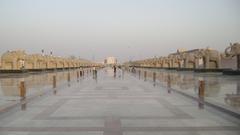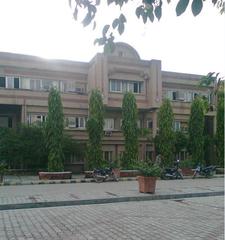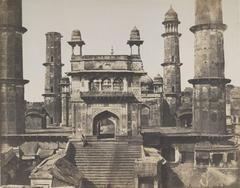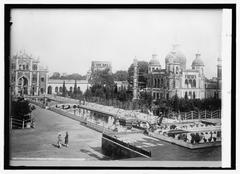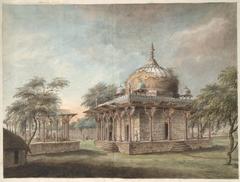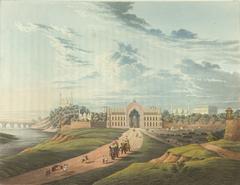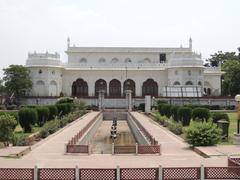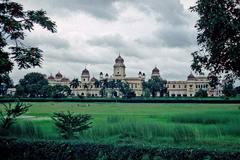Visiting Nawab Wajid Ali Shah Zoological Garden: Hours, Tickets, and Highlights in Lucknow, India
Publication Date: 17/07/2024
Introduction to Nawab Wajid Ali Shah Zoological Garden
The Nawab Wajid Ali Shah Zoological Garden, commonly known as the Lucknow Zoo, stands as a testament to the rich cultural and historical heritage of Lucknow, India. Established in 1921 to commemorate the visit of the Prince of Wales, the zoo has evolved into one of India’s most prominent zoological gardens. Renamed in 2001 in honor of Nawab Wajid Ali Shah, the last Nawab of Awadh, the zoo not only serves as a center for wildlife conservation and education but also as a recreational haven for over 1.5 million annual visitors (source).
Spanning 71.6 acres, the zoo offers a blend of natural beauty and architectural elegance, featuring over 1,000 species of trees, shrubs, and herbs. Visitors can explore a variety of animal exhibits, historical structures, and modern amenities designed to enhance their experience. The zoo is actively involved in wildlife conservation, participating in breeding programs for endangered species like the White Tiger, Bengal Tiger, and Indian Rhinoceros. In addition, it serves as an educational and research hub, collaborating with various institutions to promote environmental awareness and scientific understanding.
This comprehensive guide aims to provide detailed information about the Nawab Wajid Ali Shah Zoological Garden, including its history, visiting hours, ticket prices, major attractions, and conservation efforts. Whether you are a wildlife enthusiast, a history buff, or simply looking for a day of family fun, this guide will ensure you have a memorable and educational experience at the Lucknow Zoo.
Table of Contents
- Introduction
- History and Significance
- Visitor Information
- Major Attractions
- Architectural and Botanical Significance
- Contribution to Wildlife Conservation
- Educational and Research Significance
- Cultural and Recreational Importance
- Role in Promoting Tourism
- Modernization and Development
- Environmental Initiatives
- Community Engagement and Outreach
- Nearby Attractions and Travel Tips
- Future Prospects
- Conclusion
- FAQ
History and Significance
Establishment and Early Years
The Nawab Wajid Ali Shah Zoological Garden, originally named the Prince of Wales Zoological Gardens, was established in 1921 to commemorate the visit of the Prince of Wales to Lucknow. The foundation stone was laid by Sir Harcourt Butler, the then Governor of the United Provinces. The zoo was opened to the public on November 29, 1921, and has since become one of the most significant zoological gardens in India.
Naming and Dedication
In 2001, the zoo was renamed in honor of Nawab Wajid Ali Shah, the last Nawab of Awadh, who was known for his patronage of arts and culture. This renaming was a tribute to his contributions to the cultural heritage of Lucknow. Nawab Wajid Ali Shah was a significant figure in the history of Lucknow, and his legacy is celebrated through this zoological garden.
Visitor Information
Visiting Hours
The Nawab Wajid Ali Shah Zoological Garden is open throughout the year except on Mondays. The visiting hours are as follows:
- Summer (April to September): 8:30 AM to 5:30 PM
- Winter (October to March): 8:30 AM to 5:00 PM
Ticket Prices
The ticket prices for the zoo are quite affordable, making it accessible to a wide range of visitors. As of the latest update, the ticket prices are:
- Adults: INR 60
- Children (3 to 12 years): INR 30
- Students (with valid ID): INR 20
- Senior Citizens: Free
Tickets can be purchased at the entrance or online through the official website of the Nawab Wajid Ali Shah Zoological Garden.
Major Attractions
Animal Exhibits
The Nawab Wajid Ali Shah Zoological Garden is home to a diverse range of animal species. Visitors can expect to see over 1,000 animals representing more than 100 species. Key exhibits include:
- Big Cats: The zoo houses majestic big cats such as Bengal tigers, white tigers, and Asiatic lions. These exhibits are designed to mimic the natural habitats of these predators, providing an educational experience about their behaviors and conservation status.
- Primates: The primate section features various species of monkeys, including the Hanuman langur and rhesus macaque. The zoo also has a family of chimpanzees, which are a major draw for visitors.
- Bird Aviary: The aviary is a haven for bird enthusiasts, showcasing a variety of species such as peafowls, parrots, and hornbills. The aviary is designed to allow birds to fly freely, offering a more naturalistic viewing experience.
- Reptile House: This section includes a range of reptiles, from Indian pythons to crocodiles. The reptile house is particularly popular among children and those interested in herpetology.
Museum and Aquarium
- State Museum: Located within the zoo premises, the State Museum of Lucknow offers a glimpse into the rich cultural and historical heritage of Uttar Pradesh. The museum’s collection includes ancient artifacts, sculptures, and a gallery dedicated to the history of the region.
- Aquarium: The zoo also features an aquarium that houses a variety of freshwater and marine fish. The aquarium is designed to educate visitors about aquatic ecosystems and the importance of marine conservation.
Toy Train
One of the unique attractions of the Nawab Wajid Ali Shah Zoological Garden is the toy train, which offers a scenic tour of the zoo. The train ride is particularly popular among families with young children, providing a fun and relaxing way to explore the zoo’s extensive grounds.
Butterfly Park
The Butterfly Park is a relatively new addition to the zoo and has quickly become a favorite among visitors. The park is home to numerous species of butterflies, and the lush, flower-filled environment is designed to attract and sustain these delicate insects. Informational boards provide insights into the life cycle and habits of butterflies, making it an educational experience as well.
Architectural and Botanical Significance
The zoo is spread over an area of 71.6 acres and is designed in a manner that blends natural beauty with architectural elegance. The landscape includes a variety of flora, with over 1,000 species of trees, shrubs, and herbs. The botanical diversity not only enhances the aesthetic appeal of the zoo but also provides a natural habitat for the animals.
Contribution to Wildlife Conservation
The Nawab Wajid Ali Shah Zoological Garden plays a crucial role in wildlife conservation. It is a member of the Central Zoo Authority of India and participates in various conservation programs. The zoo is involved in the breeding of endangered species such as the White Tiger, Bengal Tiger, and Indian Rhinoceros. These efforts contribute to the preservation of biodiversity and the protection of endangered species.
Educational and Research Significance
The zoo serves as an educational and research center. It offers educational programs for students and visitors to raise awareness about wildlife conservation and environmental protection. The zoo also collaborates with various research institutions for studies on animal behavior, genetics, and conservation biology. These initiatives enhance the scientific understanding of wildlife and contribute to conservation efforts.
Cultural and Recreational Importance
The zoo is an important cultural and recreational destination in Lucknow. It attracts over 1.5 million visitors annually, making it one of the most visited tourist attractions in the city. The zoo offers a variety of recreational activities, including boat rides, toy train rides, and a children’s park. These attractions make the zoo a popular destination for families and tourists.
Special Events and Guided Tours
The zoo hosts special events throughout the year, including wildlife awareness days, educational workshops, and cultural performances. Guided tours are available for visitors who wish to learn more about the zoo’s history, its inhabitants, and conservation efforts. These tours are conducted by knowledgeable guides and provide a deeper understanding of the zoo’s significance.
Role in Promoting Tourism
The Nawab Wajid Ali Shah Zoological Garden plays a significant role in promoting tourism in Lucknow. It is part of the city’s rich cultural and historical heritage and is included in various tourist circuits. The zoo’s strategic location in the heart of the city makes it easily accessible to tourists. The presence of the zoo enhances the overall tourist experience in Lucknow and contributes to the local economy.
Modernization and Development
In recent years, the zoo has undergone several modernization and development projects. These include the construction of new enclosures, improvement of existing facilities, and the introduction of new attractions. The zoo has also implemented various measures to enhance the welfare of the animals, such as providing naturalistic habitats and enrichment activities. These efforts ensure that the zoo remains a modern and well-maintained facility.
Environmental Initiatives
The zoo is committed to environmental sustainability and has implemented various green initiatives. These include rainwater harvesting, solar energy utilization, and waste management programs. The zoo also conducts tree plantation drives and promotes eco-friendly practices among visitors. These initiatives contribute to the conservation of natural resources and the promotion of environmental awareness.
Community Engagement and Outreach
The zoo actively engages with the local community through various outreach programs. These include wildlife awareness campaigns, school visits, and community events. The zoo also collaborates with local NGOs and government agencies for conservation and education initiatives. These efforts foster a sense of community involvement and support for wildlife conservation.
Nearby Attractions and Travel Tips
Visitors to the zoo can also explore nearby historical sites such as the Bara Imambara, Chota Imambara, and Rumi Darwaza. It is advisable to plan your visit during weekdays to avoid the weekend rush. Comfortable footwear is recommended as the zoo covers a large area, and you may need to walk extensively to explore all its attractions.
Future Prospects
The Nawab Wajid Ali Shah Zoological Garden has ambitious plans for the future. These include the expansion of the zoo, the introduction of new species, and the development of new facilities. The zoo aims to enhance its role as a center for wildlife conservation, education, and recreation. These future prospects ensure that the zoo will continue to be a significant landmark in Lucknow.
Conclusion
The Nawab Wajid Ali Shah Zoological Garden is more than just a zoo; it is a historical, cultural, and educational hub that continues to evolve with the times. Whether you’re a wildlife enthusiast, a history buff, or simply looking for a fun day out, the Lucknow Zoo offers something for everyone. Plan your visit today and discover the myriad attractions this iconic zoo has to offer.
For more information, you can visit the official website of the Nawab Wajid Ali Shah Zoological Garden.
FAQ
Q: What are the visiting hours for the Nawab Wajid Ali Shah Zoological Garden?
A: The visiting hours are 8:30 AM to 5:30 PM in summer (April to September) and 8:30 AM to 5:00 PM in winter (October to March). The zoo is closed on Mondays.
Q: How much are the tickets for the Lucknow Zoo?
A: Ticket prices are INR 60 for adults, INR 30 for children (3 to 12 years), INR 20 for students (with valid ID), and free for senior citizens.
Q: Are there any special events or guided tours available at the zoo?
A: Yes, the zoo hosts special events throughout the year and offers guided tours for visitors.
Q: What nearby attractions can be visited along with the zoo?
A: Nearby attractions include the Bara Imambara, Chota Imambara, and Rumi Darwaza.
Q: What environmental initiatives has the zoo implemented?
A: The zoo has implemented initiatives such as rainwater harvesting, solar energy utilization, waste management programs, and tree plantation drives.
Summary and Key Points
The Nawab Wajid Ali Shah Zoological Garden is much more than a tourist attraction; it is a vital institution for wildlife conservation, education, and cultural heritage in Lucknow. Established in 1921 and named in honor of Nawab Wajid Ali Shah, the zoo has grown to become one of India’s most significant zoological gardens. It plays a crucial role in the conservation of endangered species like the Bengal Tiger and Indian Rhinoceros through its captive breeding programs and habitat restoration efforts (source).
The zoo’s commitment to education and research is evident through its various programs aimed at raising awareness about wildlife conservation and environmental protection. With over 1.5 million visitors annually, the zoo also serves as a major recreational and cultural hub in Lucknow, offering a variety of attractions such as historical structures, a toy train, and a butterfly park. Recent modernization and development projects ensure that the zoo remains a state-of-the-art facility, providing a safe and enriching environment for both animals and visitors.
As the Nawab Wajid Ali Shah Zoological Garden continues to evolve, its future prospects include the expansion of species, the introduction of new facilities, and enhanced conservation efforts. Whether you are visiting for education, recreation, or to support conservation initiatives, the Lucknow Zoo offers something for everyone. Plan your visit today to explore the myriad attractions and contribute to the ongoing efforts in wildlife conservation.
References and Further Reading
- Nawab Wajid Ali Shah Zoological Garden - History, Visiting Hours, and Tickets, 2024, source
- Nawab Wajid Ali Shah Zoological Garden - Visiting Hours, Tickets, and Attractions in Lucknow, 2024, source
- Conservation Efforts at Nawab Wajid Ali Shah Zoological Garden - History, Programs, and Visitor Involvement, 2024, source
